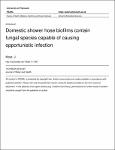Domestic shower hose biofilms contain fungal species capable of causing opportunistic infection
| dc.contributor.author | Moat, J | |
| dc.contributor.author | Rizoulis, A | |
| dc.contributor.author | Fox, G | |
| dc.contributor.author | Upton, Mathew | |
| dc.date.accessioned | 2018-03-12T10:50:00Z | |
| dc.date.accessioned | 2018-03-12T10:52:05Z | |
| dc.date.available | 2018-03-12T10:50:00Z | |
| dc.date.available | 2018-03-12T10:52:05Z | |
| dc.date.issued | 2016-04-01 | |
| dc.identifier.uri | http://hdl.handle.net/10026.1/11067 | |
| dc.description.abstract |
The domestic environment can be a source of pathogenic bacteria. We show here that domestic shower hoses may harbour potentially pathogenic bacteria and fungi. Well-developed biofilms were physically removed from the internal surface of shower hoses collected in four locations in England and Scotland. Amplicon pyrosequencing of 16S and 18S rRNA targets revealed the presence of common aquatic and environmental bacteria, including members of the Actinobacteria, Alphaproteobacteria, Bacteroidetes and non-tuberculous Mycobacteria. These bacteria are associated with infections in immunocompromised hosts and are widely reported in shower systems and as causes of water-acquired infection. More importantly, this study represents the first detailed analysis of fungal populations in shower systems and revealed the presence of sequences related to Exophiala mesophila, Fusarium fujikuroi and Malassezia restricta. These organisms can be associated with the environment and healthy skin, but also with infection in compromised and immuno-competent hosts and occurrence of dandruff. Domestic showering may result in exposure to aerosols of bacteria and fungi that are potentially pathogenic and toxigenic. It may be prudent to limit development of these biofilms by the use of disinfectants, or regular replacement of hoses, where immuno-compromised persons are present. | |
| dc.language.iso | en | |
| dc.relation.replaces | http://hdl.handle.net/10026.1/11066 | |
| dc.relation.replaces | 10026.1/11066 | |
| dc.title | Domestic shower hose biofilms contain fungal species capable of causing opportunistic infection | |
| dc.type | journal-article | |
| plymouth.publication-status | Published | |
| plymouth.journal | Journal of Water and Health | |
| dc.identifier.doi | 10.2166/wh.2016.297 | |
| plymouth.organisational-group | /Plymouth | |
| plymouth.organisational-group | /Plymouth/Faculty of Health | |
| plymouth.organisational-group | /Plymouth/REF 2021 Researchers by UoA | |
| plymouth.organisational-group | /Plymouth/REF 2021 Researchers by UoA/UoA01 Clinical Medicine | |
| plymouth.organisational-group | /Plymouth/Research Groups | |
| plymouth.organisational-group | /Plymouth/Research Groups/Institute of Translational and Stratified Medicine (ITSMED) | |
| plymouth.organisational-group | /Plymouth/Research Groups/Institute of Translational and Stratified Medicine (ITSMED)/CBR | |
| plymouth.organisational-group | /Plymouth/Users by role | |
| plymouth.organisational-group | /Plymouth/Users by role/Academics | |
| plymouth.organisational-group | /Plymouth/Users by role/Researchers in ResearchFish submission | |
| dcterms.dateAccepted | 2016-03-16 | |
| dc.rights.embargoperiod | Not known | |
| rioxxterms.versionofrecord | 10.2166/wh.2016.297 | |
| rioxxterms.licenseref.uri | http://www.rioxx.net/licenses/all-rights-reserved | |
| rioxxterms.licenseref.startdate | 2016-04-01 | |
| rioxxterms.type | Journal Article/Review |


